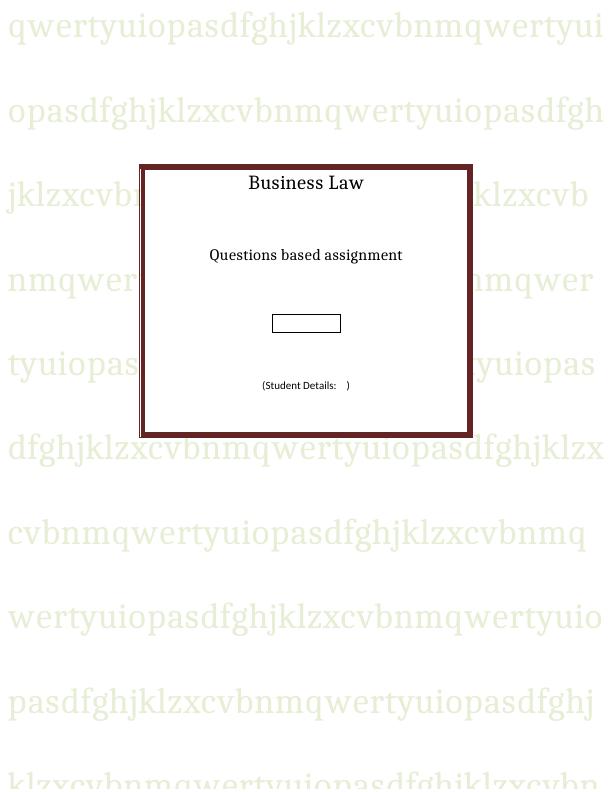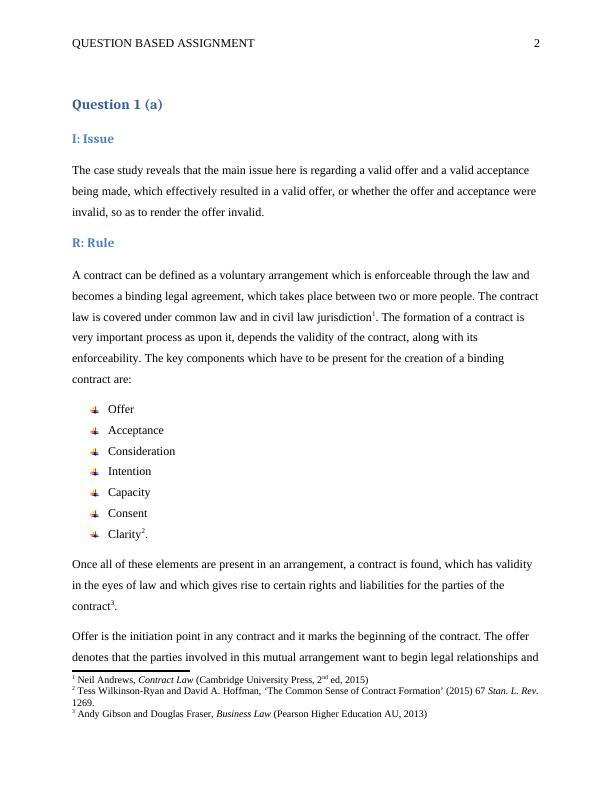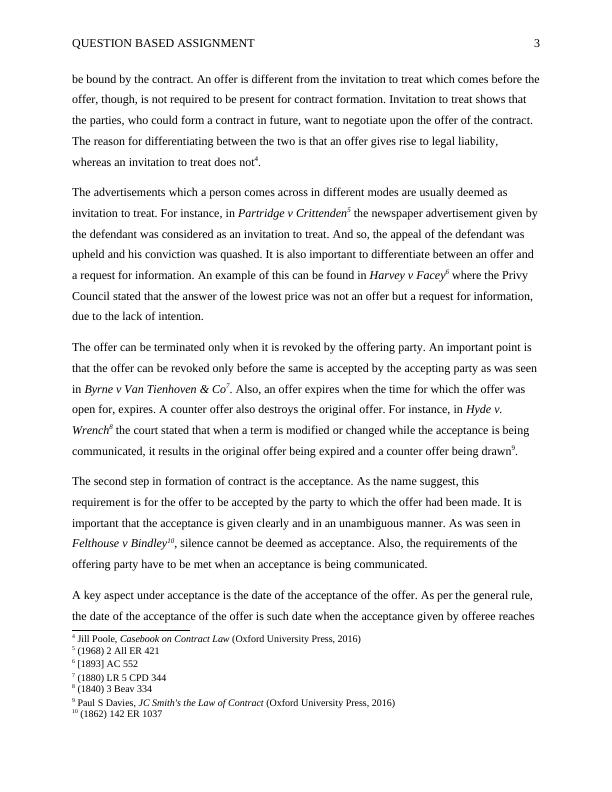Case Study on Offer and Acceptance - Desklib
Added on 2020-04-07
11 Pages3122 Words1127 Views
qwertyuiopasdfghjklzxcvbnmqwertyuiopasdfghjklzxcvbnmqwertyuiopasdfghjklzxcvbnmqwertyuiopasdfghjklzxcvbnmqwertyuiopasdfghjklzxcvbnmqwertyuiopasdfghjklzxcvbnmqwertyuiopasdfghjklzxcvbnmqwertyuiopasdfghjklzxcvbnmqwertyuiopasdfghjklzxcvbnmqwertyuiopasdfghjklzxcvbnmqwertyuiopasdfghjklzxcvbnmqwertyuiopasdfghjklzxcvbnmqwertyuiopasdfghjklzxcvbnBusiness LawQuestions based assignment(Student Details: )

QUESTION BASED ASSIGNMENT2Question 1 (a)I: IssueThe case study reveals that the main issue here is regarding a valid offer and a valid acceptance being made, which effectively resulted in a valid offer, or whether the offer and acceptance were invalid, so as to render the offer invalid. R: RuleA contract can be defined as a voluntary arrangement which is enforceable through the law and becomes a binding legal agreement, which takes place between two or more people. The contractlaw is covered under common law and in civil law jurisdiction1. The formation of a contract is very important process as upon it, depends the validity of the contract, along with its enforceability. The key components which have to be present for the creation of a binding contract are:OfferAcceptanceConsiderationIntention CapacityConsent Clarity2.Once all of these elements are present in an arrangement, a contract is found, which has validity in the eyes of law and which gives rise to certain rights and liabilities for the parties of the contract3.Offer is the initiation point in any contract and it marks the beginning of the contract. The offer denotes that the parties involved in this mutual arrangement want to begin legal relationships and1 Neil Andrews, Contract Law (Cambridge University Press, 2nd ed, 2015)2Tess Wilkinson-Ryan and David A. Hoffman, ‘The Common Sense of Contract Formation’ (2015) 67 Stan. L. Rev.1269.3 Andy Gibson and Douglas Fraser, Business Law (Pearson Higher Education AU, 2013)

QUESTION BASED ASSIGNMENT3be bound by the contract. An offer is different from the invitation to treat which comes before theoffer, though, is not required to be present for contract formation. Invitation to treat shows that the parties, who could form a contract in future, want to negotiate upon the offer of the contract. The reason for differentiating between the two is that an offer gives rise to legal liability, whereas an invitation to treat does not4.The advertisements which a person comes across in different modes are usually deemed as invitation to treat. For instance, in Partridge v Crittenden5 the newspaper advertisement given bythe defendant was considered as an invitation to treat. And so, the appeal of the defendant was upheld and his conviction was quashed. It is also important to differentiate between an offer and a request for information. An example of this can be found in Harvey v Facey6 where the Privy Council stated that the answer of the lowest price was not an offer but a request for information, due to the lack of intention. The offer can be terminated only when it is revoked by the offering party. An important point is that the offer can be revoked only before the same is accepted by the accepting party as was seenin Byrne v Van Tienhoven & Co7. Also, an offer expires when the time for which the offer was open for, expires. A counter offer also destroys the original offer. For instance, in Hyde v. Wrench8 the court stated that when a term is modified or changed while the acceptance is being communicated, it results in the original offer being expired and a counter offer being drawn9. The second step in formation of contract is the acceptance. As the name suggest, this requirement is for the offer to be accepted by the party to which the offer had been made. It is important that the acceptance is given clearly and in an unambiguous manner. As was seen in Felthouse v Bindley10, silence cannot be deemed as acceptance. Also, the requirements of the offering party have to be met when an acceptance is being communicated. A key aspect under acceptance is the date of the acceptance of the offer. As per the general rule, the date of the acceptance of the offer is such date when the acceptance given by offeree reaches 4 Jill Poole, Casebook on Contract Law (Oxford University Press, 2016)5 (1968) 2 All ER 4216 [1893] AC 5527 (1880) LR 5 CPD 3448 (1840) 3 Beav 3349 Paul S Davies, JC Smith's the Law of Contract (Oxford University Press, 2016)10 (1862) 142 ER 1037

QUESTION BASED ASSIGNMENT4the offeror. Though, a very famous exception to this rule is the postal rule of acceptance. Under the postal rule of acceptance, the date of posting the acceptance letter with the postal office is to be taken as the date of the acceptance of the offer11. The reason for this was given in the case of Byrne v Van Tienhoven as the court held that the postal office was the agent of the offering party as they specified post as a valid method of acceptance. The postal rules of acceptance are also applied on the communication of offer and acceptance which is sent through emails. Hence, the date on which this letter actually reaches or is read by the offering party is not relevant. This applicability is based on the Electronic Transaction Act, 199912. Section 14 of this act states that the date and time of the offer or acceptance is such a date and time on which the email leaves thecomputer system of the sending party13. So, here also, the date on which the receiver reads or the reaching date of the communication is not relevant. The other aspects of contract formation include the presence of a valid consideration, whereby the need is for the consideration to have economic value. Further, the consideration has to be sufficient and not adequate, so it can be mutually decided between the parties14. The next step in the formation of contract is having clarity regarding the terms on which the contract is being formed. There is also a need for the parties to the contract, to have the legal age and sound mind, for them to have the contracting parties for getting into a contract. Lastly, there is a need for the contracting parties to consent to the contract in a free manner, where they are not forced to get into the contract15. A: Application The rules which had been decided in the preceding segment now have to be applied to the given case study, to resolve the issue which were raised in the first part of this discussion. One thing is very clear that the case study had its focus upon two key elements, i.e. offer and acceptance. The advertisement in the newspaper, which was read by Lianne, would be considered as an invitationto treat. This is because firstly, the quotes were invited in this case from the public for getting a party arranged for the reader. And secondly, on the basis of applicability of Partridge v 11 Ewan McKendrick, Contract Law (Pearson Education Limited, 11th ed, 2015)12 Electronic Transaction Act, 1999 (Cth)13 Electronic Transaction Act 1999, s1414 James Marson and Katy Ferris, Business Law Concentrate: Law Revision and Study Guide (Oxford University Press, 3rd ed, 2016)15 Catherine Elliott and Frances Quinn, Contract Law (Pearson Education Limited, 9th ed, 2013)

End of preview
Want to access all the pages? Upload your documents or become a member.
Related Documents
Contract Business Law Assignmentlg...
|9
|2851
|84
Formation of Valid Contract: Case Analysislg...
|5
|1530
|437
(BLO1105) Business Law PDFlg...
|8
|1821
|85
IRAC Methods Business Law Assignmentlg...
|12
|2806
|564
Contract Law Assignment - (Solved)lg...
|15
|4552
|86
Business Law and Ethics: Case Studies on Remedies and Rights in Contract Lawlg...
|7
|1865
|368
